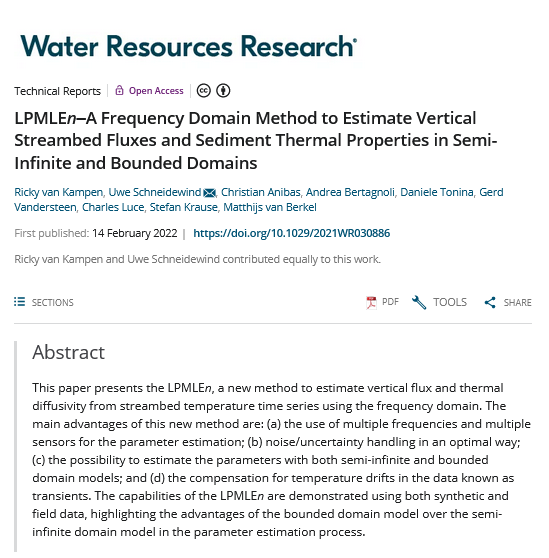Fusion scientists at DIFFER, together with an international team of groundwater researchers, have written a paper on new ways to determine how fast groundwater enters or exits the river. This is directly related to how the temperature in the riverbed changes. By measuring the temperature at different soil depths, they can determine the relevant heat transport parameters. And that is something that is also done frequently in fusion research. An interview with Ricky van Kampen and Matthijs van Berkel.
![]() Lees dit interview in het Nederlands
Lees dit interview in het Nederlands

Photo: DIFFER
Matthijs van Berkel, you are the group leader of Energy Systems and Control at DIFFER. What made you work on groundwater?
“When I had my sabbatical at the Vrije Universiteit Brussel, I came into contact with Gerd Vandersteen. Together with hydrologists, he was working on a method to estimate heat transport. I was working on something similar, but for fusion. Thanks to Gerd, I got the inspiration for two improved methods. One for fusion plasmas and one for water fluxes.”
Why do hydrologists need to estimate whether groundwater flows into the river? Can't they simply see that?
“No, you can't just have a look at what's happening in the ground. So that's why you have to measure it. Thermometers are an easy, cheap and reliable way of measuring. Hydrologists place a stick with thermometers at the bottom of the river. After a month or more, they take it out and analyze the data.”
Why is it so important to monitor groundwater?
“From groundwater, for example, pollution can seep into the river. This can cause problems downstream at purification plants. Or fish and other flora and fauna may die. So if you know the condition of the groundwater, you can identify hot spots or hot moments. Next, you can use water management to regulate groundwater flows.”
Okay, that sounds good, but how does the temperature method work?
“We are taking measurements of the temperature of the ground and groundwater at several depths. We do that every few minutes. So you get a huge amount of data. But we're used to that in fusion research. We feed that data into a model. With the model, we can predict the groundwater flow.”

Photo: Shari Bruijstens
Ricky van Kampen, you are a PhD student in Matthijs' group, what is your contribution?
“I have further developed the methods of Matthijs and Gerd such that we can better compare the estimates based on two different models. We also applied the method directly to data from a small branch of the Belgian river Aa. That is an area of which hydrologists already have a lot of data.”
So, is it working?
“Yes. Using simulations, we show that the method and the models are correct. The models have been validated so to speak. We also show where the limits of the old model are and how our new model pushes those limits. The experimental results in the field are promising. It is now up to the hydrologists to explain the estimated groundwater flows based on external factors, such as rainfall and water level.”
What are you going to do next? Will you continue with water research?
“No, I will dive deeper into fusion research. I'm going to estimate space-dependent transport coefficients within fusion. In other words, I'll be looking at whether the location in a plasma affects heat transport. And of course, this can be used later in hydrology, again. Because different soil layers can have different transport parameters. And that's spatial dependency, too.”
Finally, Matthijs, what is the lesson, the moral of the story?
“Our collaboration with hydrologists propelled both fields. It is an example that fusion research also adds value to society outside fusion.”
Scientific paper
R.J.R. van Kampen, U. Schneidewind, C. Anibas, A. Bertagnoli, D. Tonina, G. Vandersteen, C.H. Luce, S. Krause, M. van Berkel, LPMLEn - A frequency domain method to estimate vertical streambed fluxes and sediment thermal properties in semi-infinite and bounded domains, Water Resources Research 58 (2022) e2021WR030886, DOI (open access)
More information
DIFFER group Energy Systems and Control
Go to the News page.